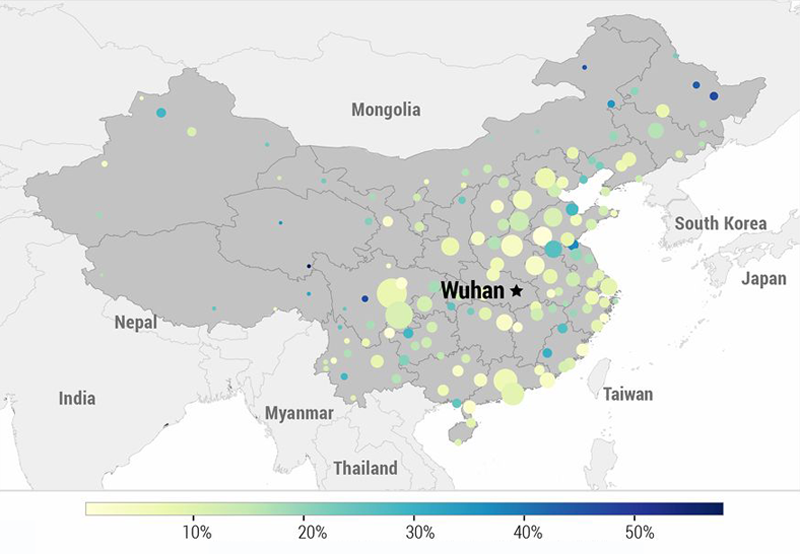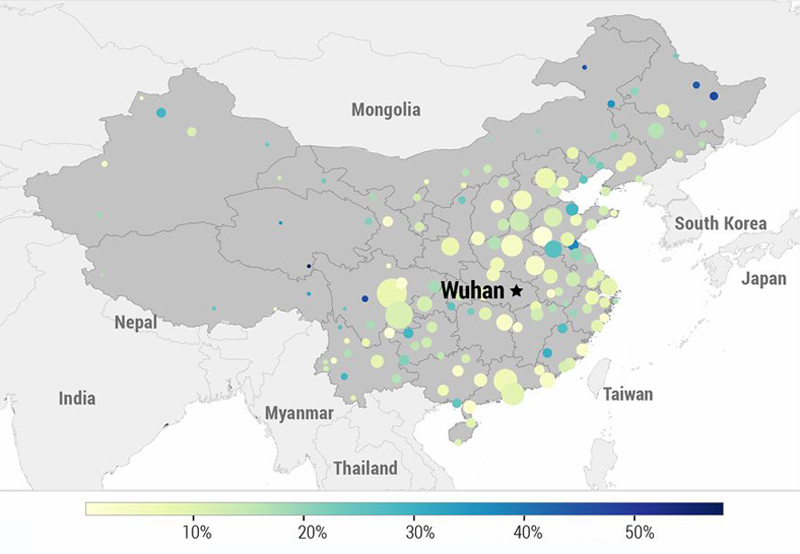Forecasting COVID-19’s Trajectory
As COVID-19 spreads like wildfire across the globe, politicians must weigh difficult options to mitigate its impact. When and for how long should schools be closed? Do entire cities need to be quarantined? What social distancing measures are most effective? Which businesses must halt their activities? To what extent should local and international travel be curtailed?
These decisions are guided by infectious-disease modelers, and physicists are an influential part of the mix. Harnessing today’s computing power, they solve models that capture the probabilistic nature of viral transmission and the dynamics of social behavior, delivering quantitative predictions with ever-increasing accuracy.
“Physicists have an arsenal of theoretical and computational tools that are suitable for epidemiology,” says Alessandro Vespignani, who directs the Network Science Institute at Northeastern University in Boston. He also advised the World Health Organization and the Centers for Disease Control and Prevention during the Ebola and Zika outbreaks.
Vespignani points to several approaches developed in physics that are relevant for describing disease spread. One example is the mathematical model that describes diffusion-controlled reactions, in which chemicals spread in a liquid and react upon contact. Another powerful tool is network theory, which represents individuals or clusters of individuals as interconnected nodes, much like train stations on a transit map. The theory can forecast the rate at which an infection spreads through a population based on patterns of human interaction, such as the way people cluster at specific times during the daily commute.
Crucially, network theorists can integrate massive amounts of real data into their models, using publicly available databases on air travel and ground mobility. Thanks to the enormous amount of computing power available today—Vespignani, for instance, has access to Google’s powerful cloud computing system—researchers are able to produce global maps of a disease’s expected evolution with the spatial resolution of a few city blocks.
In a recent article in Science, Vespignani’s team used network theory to analyze how travel bans affect the spread of COVID-19. The study looked specifically at the quarantining in Wuhan, China (the pandemic’s source) and at the restricting of travel into and out of mainland China—rules that were put in place about a month after the initial outbreak and after infected individuals had already traveled outside of Wuhan. According to the simulations, the travel bans only delayed the onset of outbreaks elsewhere in China by a few days and by two to three weeks in the rest of the world. “Travel restrictions have little benefit if we don’t halt the virus transmission locally,” Vespignani explains. The ban bought some time, he says, but it didn’t stop the virus from spreading globally. Without drastic social distancing rules on the local scale, even 90% reductions in global travel are insufficient, he says.
Dissecting the role of these local interactions is a goal for Alexandre Arenas, an expert on complex systems at the University of Rovira i Virgili in Tarragona, Spain. His country is one of the fastest growing centers of the pandemic, and he and his team are doing double duty to rapidly update their predictions and share them with policy makers. “We are fighting a war to raise awareness on the urgency to act,” he says. “There are ways to stop this virus, but we need to move much more swiftly.”
Daily, Arenas’ team, in collaboration with the group of Jesús Gómez-Gardeñes at the University of Zaragoza, Spain, updates a simulation that forecasts the number of cases in each Spanish municipality. As inputs, they use the current number of cases, estimates of the disease’s incubation time and infection rate, and publicly available mobility data. The researchers then compare their forecast with the number of patients that the local health system can treat.
Their most recent predictions are alarming—and seemingly accurate. A map of Spain shared on March 14th suggested that some of Spain’s hardest-hit provinces, like La Rioja and Álava, would be overloaded by March 18th. Newer simulations indicate that the same could happen within a few days in many other provinces without restrictions on human contact. Politicians are now paying attention. His report informed the lockdown measures of the Catalonian government, and on March 19th, Spain’s prime minister requested the team’s input. The governments of Uruguay and Argentina have also asked the team to run simulations for their countries.
With no vaccine or cure available, the only way to control the disease is through dramatic changes in social behavior, Arenas explains. According to his estimates, individuals in Spain should interact with no more than three other people per day in order to avoid overloading the country’s hospitals and medical-care facilities.
Another physicist-turned-epidemiologist, Vittoria Colizza of the French National Institute of Health and Medical Research applies network and complex-systems tools to inform public health authorities. Crowdsourcing provides her with real-time data from 6000 volunteers and 1200 “sentinel” medical practices in France, helping her survey infectious diseases.
On Wednesday March 18th, she posted the results of simulations that predicted the effect of closing schools. Analyzing the three areas of France with the highest number of known cases, she found that simply closing schools for eight weeks should only reduce the peak number of cases by 10%. But when coupled with a requirement that 25% of adults work from home over the same timeframe, the peak should both drop by 40% and be delayed by two months.
Colizza acknowledges certain uncertainties in her model, since experts still don’t know how easily children are infected by the disease or how likely they are to transmit it. And while shutting down schools breaks one pathway for infection, it can open up others—for instance because caregivers replace teachers. Of course, drastic measures such as closing schools and imposing quarantines also have huge impacts on the population, and no network modeler can make the final call on whether the good of these actions outweighs the bad. “It’s up to policy makers to decide,” Vespignani says.
Still, scientists’ increasingly accurate calculations can provide rational, quantitative input to these decisions in the same way that weather reports guide governments bracing for a storm. “We want to give epidemiology the same predictive power as meteorology,” Vespignani says. He adds that while it’s impossible to divert an extreme weather event—a hurricane doesn’t care if you predict its path—epidemiological tools can help find the best ways to put down a virus.
Matteo Rini is the Deputy Editor of Physics.







